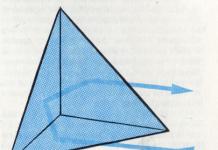1. General information
1.1. Real products - wooden window and door balcony blocks of a single design with double-glazed windows, are a modern design certified in the GOST R Certification System for use in standard or individual construction.
1.2. The results of certification tests of wooden window and door balcony blocks with double-glazed windows, manufactured by 33 Du6a LLC.
1.2.1. The coefficient of reduced resistance to heat transfer (): for products with a double-glazed window 40 mm (4-16-4-12-4) - 0.706, which corresponds to the class "B1". Scope - residential and public buildings and structures.
1.2.2. Noise absorption for products with double-glazed windows - 26 dB.
1.2.3. The air permeability of products with a double-circuit seal corresponds to class "A".
1.2.4. Reliability of window devices and hinges - 20,000 cycles without destruction, damage and change in shape.
1.3. Locking fittings from AUBI (Germany), installed on these products, can provide four types of opening: rotary, tilt, tilt-and-turn and depressurizing (night ventilation), which prevents the windows from “fogging”.
1.4. The design of the products provides highly effective sealing of the premises (no drafts through leaky joints), as a result of which it is necessary to regularly ventilate them for hygienic reasons, as well as to remove excess moisture, which manifests itself in the form of “fogging” of glasses, to prevent the formation of white corrosion on the fittings under exposure to high humidity.
High humidity leads to swelling of the wood and the subsequent appearance of surface defects. Lack of ventilation (ventilation) leads to an increase in the likelihood of wood damage by fungi.
2. Completeness
The order package includes:
2.1. Finished products with installed double-glazed windows, sealing gaskets and locking devices.
2.2. Handles with fixing screws.
2.4. Other additional elements (additional profile, window sill boards, ebbs, etc.) specified by the terms of the order.
2.5. Real passport.
3. Rules of operation and maintenance
you purchased window system that needs maintenance. To maintain the reliability of your windows for many years, you should follow these guidelines:
Opening (closing) of the valves should be carried out smoothly, without jerks;
- for rotary (normal) opening of the sash, it is necessary to turn the handle from the “closed” (down) position by 90 degrees to the horizontal position;
- for the hinged opening of the sash as a transom, it is necessary to turn the handle from the “closed” (down) position by 180 degrees to the up position;
- for depressurization ("night" ventilation), it is necessary to turn the handle from the "open" position by 45 degrees upwards.
Attention!
Only turn the handle when the sash is fully closed! When the sash is open (rotated or tilted), the handle is fixed from turning.
If, when the sash is open, it simultaneously tilts (by pressing the leaf spring while turning the handle upwards), it is necessary to set the sash to the normal position as follows:
Press on the leaf spring located on the side of the sash at the level of the handle;
- set the handle to the up position;
- close the sash like a transom and turn the handle, without releasing the spring, by 90 degrees to a horizontal position;
- release the leaf spring, close the sash completely and turn the handle to the “closed” (down) position.
If it is necessary to press the sashes tighter (“night” ventilation), turn the locking rollers with a hexagonal (S = 4 mm) key so that the mark on the locking rollers faces the seal.
Attention!
The installation of the product should be carried out after finishing work (pouring floors and plastering walls) associated with changes in humidity in the room.
Manufactured windows and doors are painted with special environmentally friendly, deeply penetrating primers and paints. Soil components protect the wood surface from various pests and rot. Thick-layer paints and glazes applied by spraying protect the surface from external influences and moisture penetration for a long time, at the same time making it vapor-permeable, which allows maintaining equilibrium moisture in the wood. Such weather-resistant coatings require special care.
Complete stabilization of the paintwork occurs two to three weeks after painting, so during this time, with direct exposure to moisture, the appearance of the wood texture, the appearance of white spots on the surface of the window, is possible. With a decrease in humidity, the spots disappear, and subsequently do not appear. This is due to the high hygroscopicity of natural wood.
A distinctive feature when painting with water-based paint systems is a slight uplift of the wood structure with the penetration of water into the product.
In addition, when priming window products made of timber glued on micro-studs transparent soils, a slight color variation on the surface of the products may occur due to the different density of the wood bars that make up the product.
However, these factors do not affect the operational properties of the paintwork.
Attention!
Depending on the environmental influences, preventive measures are required to be carried out at intervals of one to five years.
It is necessary to lubricate the moving parts of the fittings with non-absorbent technical vaseline at least once a year.
- Check the seals for damage (if the seals are damaged, they must be replaced).
- Regularly (once every six months) to clean the paint surface from dirt, you should use ordinary cleaners - solutions of washing powders. After that, treat the surface with GlasuritQuick&EasyHolzbalzam.
- If it is necessary to update the surface coating wooden windows is carried out with the help of paints and varnishes of the Glasurit company (Germany).
- Periodically check the cleanliness of the drainage holes located on the outside of the lower part of the product.
- Glass unit surface wipe with glass cleaner.
Attention!
Data window systems they close very tightly and thus save a lot of heat. To prevent this advantage from becoming a disadvantage in the form of condensation, you should ensure that the room is regularly ventilated throughout the day.
4. Warranty
These technical specifications apply to interior wooden door blocks (hereinafter referred to as doors), manufactured by LLC"XXX", Cheboksary.
doors designed for residential and public buildings.
These technical conditions apply to doors of the following types (according to GOST 6629):
- DG - doors are deaf;
- DO - glazed doors.
An example of recording products in other documents and (or) when ordering:
"Wooden interior door DG TU 5361-001-ХХХХХ-2012"
The list of reference and normative documentation of these technical specifications is presented in Appendix A.
1. TECHNICAL REQUIREMENTS
- General requirements
Doors must comply with the requirements of GOST 475, the requirements of these technical specifications and be manufactured according to the working drawings of the manufacturer.
- Main parameters and characteristics
- The appearance and color of the doors must correspond to the standard samples approved by the head of the manufacturer.
- The nominal dimensions of the doors must comply with the standards given in table 1.
Table 1
| Block designation | Door size (height x width), mm | Door block size (height x width), mm |
| 20-65 | 1900x550 | 1971x620 |
| 20-7 | 1900x600 | 1971х670 |
| 21-7 | 2000 x 600 | 2071 x 670 |
| 21-8 | 2000 x 700 | 2071 x 770 |
| 21-9 | 2000 x 800 | 2071 x 880 |
| 21-10 | 2000 x 900 | 2071 x 970 |
- Limit deviations from the nominal dimensions along curvature should not exceed± 4 mm.
- Doors, their assembly units and parts must have the correct geometric shape.
The deviation of door panels from flatness should not exceed
2 mm height, width and diagonal.
The deviation from the perpendicularity of the sides of the door leafs should not exceed 2 mm per 1 m.
In the corner stud joints of the boxes, the height of the sags should not exceed 0.5 mm, and in the corner junctions of the strapping of the sheets - 0.3 m. The gaps in the shoulders of the stud joints of the boxes should not be more than 1 mm.
Sag on the ends of the spiked joints in the webs is not allowed, and in the boxes there should not be more than the maximum deviations from the nominal length of the parts.
- The frame should be made of spliced pine beams, on which MDF sheets 6 mm thick are glued on both sides.
- Doors must be lined with PVC films of thickness
(0.3 - 0.4) mm.
- The moisture content of the wood of door parts should be 8± 1%.
- Connections of door parts must be made in accordance with the requirements of GOST 9330.
- The door frame, lined with MDF on both sides, is pressed in a hot double-sided press for 20 minutes.
After processing and applying the appropriate patterns, the canvas is covered with a PVC film and aged in a vacuum membrane press.
The assembly of the door leaf can also be carried out in a dry way on dowels fastened at four corners with tie screws.
- Adhesive is used for door claddingHomakol 133 according to TU 2252-007-59759080-04.
- The roughness of the front surfaces of the doors for an opaque finishing coating should not be more than 200 microns, for a transparent finishing coating - no more than 60 microns (in accordance with the requirements of GOST 7016).
Fringes and burrs in instrument sockets must be cleaned off.
- On the front surfaces of doors with decorative lining with sheet or film materials, the dimensions and number of scratches, dents, stains, as well as uneven gloss and dullness must correspond III class according to GOST 24404. Mechanical damage to the door surface (scratches, dents, abrasions) is unacceptable. Extraneous inclusions under the facing material are unacceptable. Irregularities are unacceptable.
- Types, sizes, finishes and workmanship of appliances and fasteners used for doors must meet the requirements of the standards for these products and parts and indicateper customer specification.
- Devices, flashings, layouts and other details must be fixed with screws, pins and nails in accordance with the requirements of the standards for devices and this standard.
The screws must be screwed in. Driving of screws and exit of the ends of fasteners on the door surface is not allowed.
- Glazing should be made using silicone and special inserts.
Glass used for glazing doors must comply with GOST 111, GOST 5533 and GOST 7481.
- Glass surfaces must be clean, dirt, oil stains, glass chipping, chips, glass edge protrusions, damage to glass corners are not allowed.
- Requirements for materials and purchased products
- Materials and products purchased for the manufacture of doors must comply with the requirements of GOST 475 and current regulatory documents.
- Materials purchased for the manufacture of doors, including foreign-made materials, must have a certificate of conformity or other document confirming the quality.
Polymeric and synthetic materials used for the manufacture of doors must have a sanitary and epidemiological conclusion and fire safety certificates.
- The basis of the door leaf is a frame made of spliced pine beams (humidity 8± 1%), on which MDF sheets are glued on both sides by hot pressing using industrial glue (Homakol 133 according to TU 2252-007-59759080-04) 6mm thick.
- The door leaf is covered with PVC film (GOST 24944) 0.3-0.4 mm thick. The ends of the canvas are also covered with PVC film on all four sides. Glazed doors are equipped with glass (GOST 111 / GOST 5533 / GOST 7481) thickness 4 mm (8 mm), inserted through the upper groove of the door leaf.
- Completeness
- Doors are supplied to consumers in their original packaging, separately door leafs and separately frames, trim. By agreement with the consumer, the doors and the door butt can be equipped with related fittings.
- Doors of complete factory readiness must have a final finish that does not require additional work, installed glass and sealing gaskets.
- The delivery set should include: a quality document (label on the package) and door operation instructions, including recommendations for installation.
- Marking
- Each product is marked with a waterproof marker or thesea label indicating the name of the manufacturer, the nameproduct, date of manufacture and (or) order number, sign(stamp) confirming the acceptance of the product by technical control lem.
The marking must be clear and easy to read. The method of marking should ensure its safety during transportation and storage.
- The door devices included in the product must be marked in accordance with the regulatory or technical documentation for this product.
- It is allowed to give marking in the accompanying document for the supplied batch of doors, and only its designation should be indicated on each door.
- The accompanying document for the supplied batch of doors must indicate:
- name and (or) trademark of the manufacturer;
- name and (or) symbol of the door;
- batch number and date of manufacture;
- Number of doors;
door size;
- designation of these technical conditions.
- Transport marking - according to GOST 14192.
Transport marking of glazed doors should include the handling sign “Fragile. Carefully".
It is allowed to apply other handling signs and information inscriptions that ensure the safety of doors during loading and unloading operations, transportation and storage.
- Package
- Doors must be packed in accordance with the manufacturer's drawings. Packaging should ensure the safety of products during long-term transportation and repeated shifting of warehouse storage with the observance of safety precautions.
- The finished fabric is packed in corrugated cardboard (GOST R 52901) from all 4 end sides.
- Door leafs before their transportation must be securely fastened with straps, ties or other devices that do not cause damage to products.
- Packed doors can be stacked in a horizontal position or installed in a vertical position on wooden pallets in accordance with GOST 9557, GOST 9570, GOST 22831, GOST 26381 and fastened in accordance with GOST 21650. The height of the door foot is not more than 1000 mm. The design of the pallet provides for installation in two tiers.
- By agreement with the customer, it is allowedthe use of packaging materials of other types, as well as the supply of doors in unpacked form.
6. MANUFACTURER WARRANTY
- The manufacturer guarantees that the doors comply with the requirements of these technical specifications, subject to the conditions of transportation and storage established by these technical specifications, as well as the installation instructions.
- Warranty period - 1 year from the date of completion of installation work.
To choose high-quality wooden doors - a certificate for them must be asked from the seller. If it is, then you are dealing with the products of a responsible manufacturer that complies with all technical conditions and standards.
It should be noted that the certification of wooden doors is not a mandatory procedure; only those manufacturers who are confident in the quality of their products voluntarily undergo it.
And if the product still has a certificate - wooden doors and all elements of their design are made in accordance with the requirements of GOST. And this means that you will not have to repair or replace doors in the near future.
GOST 6629-88 is regulated. The presence of a certificate of compliance with this standard means that the door is made in compliance with the technology from high-quality materials.
In addition, this GOST on wooden doors determines the parameters of attachment points, glazing (if provided), installation in the opening, etc. Despite the fact that these standards have been used for a very long time, and over the years that have passed since their adoption, many new finishing materials have appeared, there have not been major changes in the basic door production technology.
As before, today in the first place are the requirements for the quality of wood and permissible deviations from the given dimensions.
Do not think that GOST applies only to domestic-made wooden doors. Imported products are also subject to regulation, for this there is an International Standard for doors for residential, administrative, public buildings.
All components of a wooden door block, down to sealing gaskets or glass inserts (see), must be checked by the manufacturer for compliance with manufacturing specifications. The results of this check are recorded in the accompanying documents.
Types of structures regulated by GOST 6629-88
In our homes, the most common type of doors are panel doors with small-hollow filling. The noise and heat insulation properties (see) of such a door depend on the type of filling, and its decorative characteristics depend on the quality of the finish.
But there are also such parameters as functionality and strength, which are determined by compliance with all standard sizes of individual parts and their correct layout. If you look into the passport, which is attached to each batch of doors, you can find in it designations that are completely incomprehensible to an ignorant person.
For example: DO20-16 LP GOST 6629-88, PG21-10 N GOST 6629-88. To decipher them, you need to know the GOST classification of wooden doors:

- First letter D- this is a door, and P - a door leaf without a box.
- The second letter indicates the type of construction, where G is a blind canvas, Y is a reinforced canvas, O is glazed, and K is swinging (that is, capable of opening in any direction relative to a fixed axis).
- The numbers following the letters are the height and width of the opening in decimeters.
- The letters after the numbers indicate the design features of the door: P - threshold, N - with a surfacing, L - opening to the left side (opening to the right is not indicated in any way).
Thus, the code DO20-16 LP GOST 6629-88 designates a glazed double-leaf door for an opening 20 dm high and 16 dm wide, opening to the left, with a threshold, made according to GOST wooden doors. At the request of consumers, the standard allows the production of a door block of other sizes, as well as different widths of canvases for double-leaf doors of a deaf or glazed type.
At the same time, the consumer should be aware that the entire door unit, that is, the leaf and the frame, must be made from the same type of raw material and be supplied in a complete set.
GOST guarantees practicality and convenience
The buyer himself chooses the type of finish of the wooden door and the type of its construction, focusing on his preferences and the feasibility of installing just such a door. But the quality of the internal elements of the door is difficult or even impossible to check if the wooden door certificate is not provided by the supplier.
The presence of a certificate of compliance with regulatory requirements gives the buyer confidence that all technical requirements for the manufacture of this door model have been met.
GOST defines:
- The height of the door hinges
- The height of the placement of locks (see) and handles
- Ways of fastening door fittings
- Location of fillers
- Frame rib thickness
- Strap connection methods, etc.
These requirements did not arise out of nowhere, but from many years of practice in the operation of doors and trial tests, which made it possible to determine the most convenient parameters from a functional point of view.
The location of the devices at the points specified by GOST allows you to optimally distribute the forces applied to them over the entire door structure. That is, from the standpoint of maintaining the integrity of the door, the expediency of these standards is understandable.
The rigidity of the structure, the preservation of geometric parameters and noise absorption depend on how correctly the fillers are located in the body of the door - fiberboard strips, bars, paper honeycombs.
GOST 475-78
Do not think that GOST for wooden doors is necessarily monotonous shapes and textures, boring colors. In fact, the compliance of the door with the standard means only that it is assembled from high-quality materials in compliance with the assembly technology.
For this, there is GOST 475-78, which regulates literally all the nuances of manufacturing wooden doors, including quality control of the raw materials and even the dimensions of the fixing screws. But this does not prevent manufacturers and designers from creating a variety of models that amaze with their design.
Classification of doors according to GOST 475-78
According to this standard, wooden doors are distinguished by:
- Design features
- Appointment
- Method and direction of opening
- Number of canvases
- Type of finish (see)
- The presence of glazing
For interior doors, properties such as ease of opening, resistance to mechanical stress are important, while complete sound insulation or increased strength are additional conditions. If there is a non-standard high opening, it is not always necessary to make a custom-made door, since GOST on wooden interior doors provides for the option of manufacturing a standard door with a transom.
It can be both deaf and glazed, which is an additional source of natural light. According to the number of leafs, the doors can be single- and double-leaf, for double-leaf doors it is allowed to manufacture sheets of different widths.
In the direction of opening, swing doors are divided into right, left and swinging - turning in any direction around the vertical axis. Sliding doors and book doors can also be right or left depending on which way they open. When buying a door, it is important to pay attention to the method and direction of its opening.
GOST establishes the following standards for internal wooden doors:
- For rooms with constant high humidity (more than 60%), the installation of moisture-resistant doors is required. They are made from pine wood.
- Doors with normal moisture resistance are installed in rooms with normal humidity. As a rule, they are made from durable and hard hardwoods that are resistant to decay.

As for the finish, it is carried out with transparent and opaque coatings. Lacquer belongs to transparent ones, various paints, enamels, decorative film and sheet materials belong to opaque ones.
Special requirements are imposed on the front surfaces that are visible during operation of the doors.
Specifications

- How well a wooden door will perform its functions depends on its correct geometry. In this regard, GOST defines the maximum tolerances for sagging, deviation from the plane of the canvas and the vertical, which are measured in millimeters. It is almost impossible to notice these changes with the naked eye, they are determined by measurements using special tools. But in production, they must be fixed, and if the tolerance is exceeded, the doors are rejected.
- In addition, the technical conditions determine the permissible number of wood defects per unit area - cracks, knots, resin pockets. They must be sealed with corks from the same material, puttied and sanded. In short, the surface must be ideally prepared for subsequent coating.
- For small-hollow filling, slats and bars with defects and rot are not allowed. All non-facial (invisible during operation) surfaces of the door must be treated with an antiseptic or painted.
- In one model, the use of different wood is unacceptable: the material of the box must be identical to the material of the door leaf. In addition to maintaining the decorative effect, this guarantees the normal functioning of the door.
We repeat that if upon purchase you are offered to study the certificate - wooden doors are made in compliance with all of the above specifications. In addition, the certificate of conformity guarantees that the quality of finishing materials, the strength of adhesive and tenon joints, and the correct installation of devices were controlled during the manufacturing process.
GOST 475-78 stipulates the use of relevant standards and specifications for each door assembly unit. The passport of each batch of doors contains the test results, measurement data and specification for parts supplied not assembled.


















